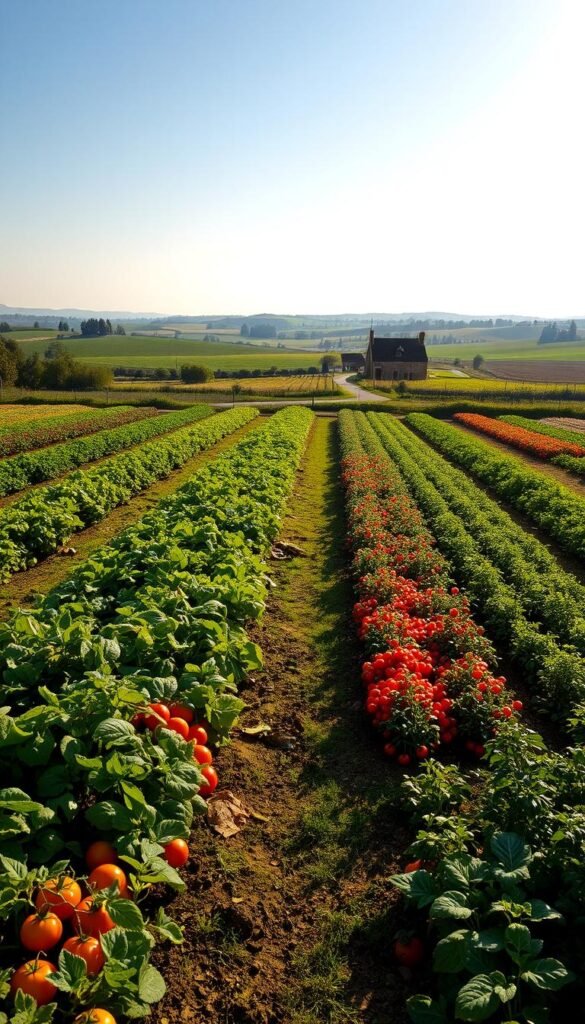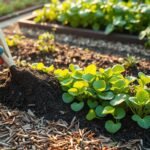Imagine stepping into a thriving oasis where every plant thrives and space works smarter, not harder. Whether you’re cultivating fresh ingredients for your kitchen or building a backyard food system, how you arrange your plot makes all the difference. Gardening expert Steven Biggs reminds us there’s no single “right” way to design – only what works best for your unique goals and environment.
This guide helps you avoid common pitfalls that leave growers frustrated. Traditional farming methods often create wasted areas and maintenance headaches in home settings. Modern approaches let you triple productivity while keeping your space manageable and visually appealing.
You’ll discover how strategic bed placement improves airflow and sunlight exposure. Learn why thoughtful pathways matter as much as planting zones. We’ll break down soil preparation secrets and accessibility tricks professionals use.
Planning transforms guesswork into predictable results. By aligning your design with nature’s patterns, you create an ecosystem where plants support each other. The best part? You don’t need fancy tools or expensive supplies – just smart organization.
Ready to turn that blank canvas into a high-yield paradise? Let’s explore how to maximize every square foot while creating a space that delights your senses and fills your harvest basket.
Understanding the Basics of Vegetable Garden Layouts
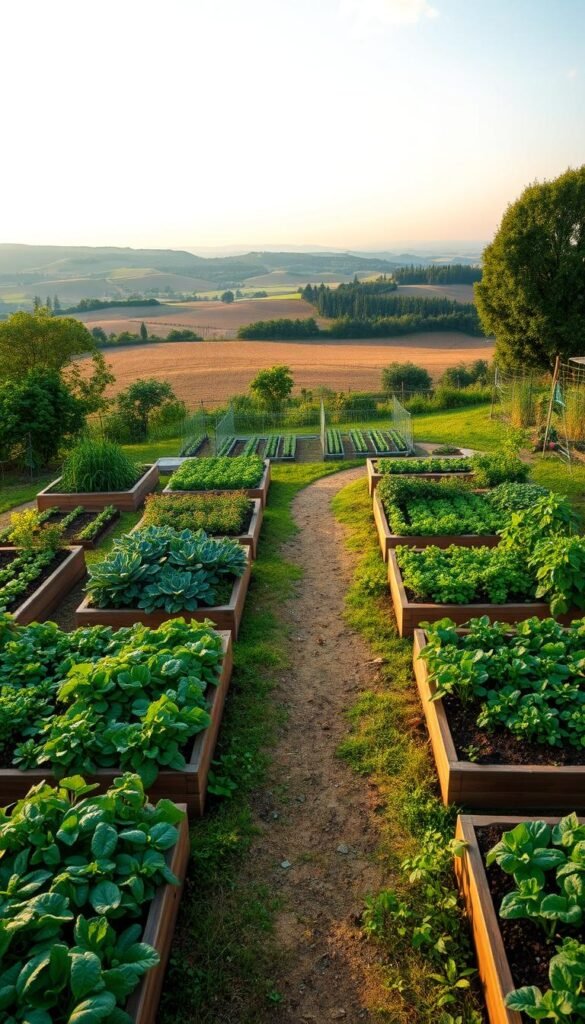
Growing food at home starts with thinking like a puzzle master. Every plant needs its perfect spot, but unlike jigsaw pieces, they grow bigger and change shape. Let’s break down the core ideas that turn random dirt patches into productive spaces.
Why Farms and Backyards Play Different Games
Commercial growers leave wide gaps between rows for tractors. Your space? It’s precious real estate. Those empty walkways become weed hotels. Instead of single-file lines, try tight clusters. A smart design packs plants closer while keeping air flowing.
Math Meets Mushrooms
Three numbers matter most: plant width, height, and spread time. Leafy greens need 6″ squares early on but triple their space in 8 weeks. Tomatoes start small but become 4′ towers. This table shows how pros adjust spacing:
| Crop Type | Seedling Space | Mature Space |
|---|---|---|
| Lettuce | 6 inches | 12 inches |
| Tomatoes | 18 inches | 36 inches |
| Carrots | 2 inches | 3 inches |
Always plan pathways first – 18″ wide lets you kneel comfortably. Curve beds around sun patterns. Tall crops belong northside so they don’t steal light. Remember: roots grow down, leaves reach up, and your harvest depends on giving both room to breathe.
Large Vegetable Garden Layout: Organizing Rows and Beds for High Yields
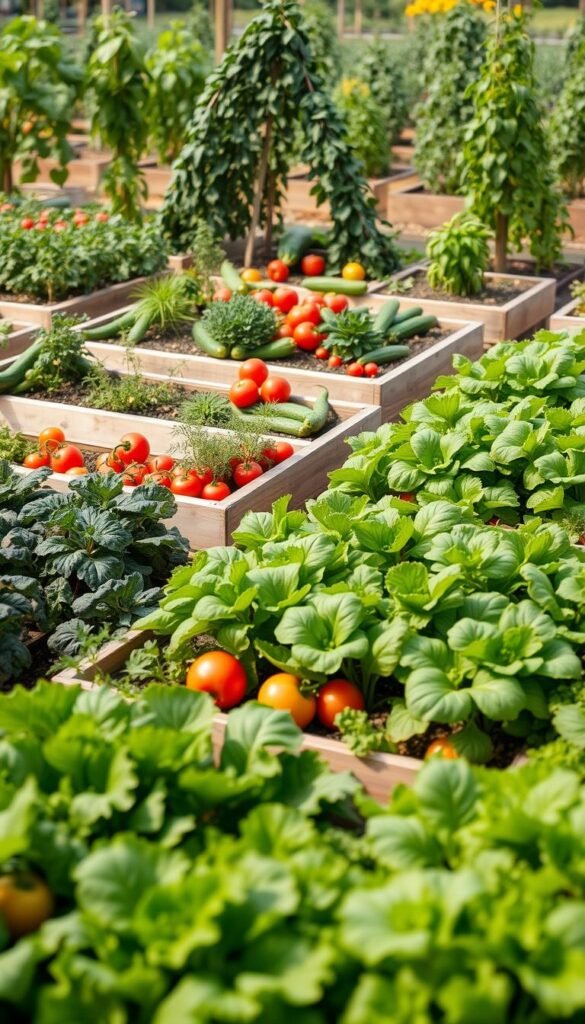
Maximize every inch of your plot by rethinking traditional planting methods. Block-style arrangements let you grow 45% more food in the same area compared to single-file rows. This approach reduces wasted soil space while keeping plants accessible.
Start by measuring your arm’s reach. Ideal bed widths range from 3-4 feet, letting you tend to center plants without compacting soil. Curved edges boost planting space by 12% compared to rigid rectangles. Pro tip: Mark pathways with wood chips to prevent accidental trampling.
Not all plants thrive in tight clusters. Use this guide to match crops with their ideal formats:
| Crop | Best Format | Reason |
|---|---|---|
| Lettuce | Blocks | Shallow roots, quick harvest |
| Carrots | Rows | Needs loose soil depth |
| Tomatoes | Rows | Demands airflow |
Position permanent beds near water sources for thirsty crops like zucchini. Rotate temporary plots annually to prevent soil depletion. Edge spaces work great for herbs – they’ll thrive in the extra sunlight between taller plants.
Angle beds northeast to southwest for even sun distribution. This simple tweak reduces shading issues by 30%. Remember, your layout should evolve as you discover which arrangements make harvesting easiest for your body and routine.
Optimizing Space with Blocks, Rows, and Raised Beds
Transform your growing area into a productivity powerhouse by choosing the right planting format. Three approaches dominate smart growers’ toolkits: dense blocks for quick harvests, traditional rows for vining crops, and elevated plots that conquer poor soil. Each method shines in specific scenarios.
Benefits of Growing in Blocks vs. Rows
Block planting packs crops like spinach and radishes tightly, creating living mulch that suppresses weeds. This method works best for plants harvested all at once. Compare it to single-file rows, which suit crops needing individual attention:
| Plant Type | Ideal Format | Yield Boost |
|---|---|---|
| Kale | Blocks | +55% |
| Green Beans | Rows | +22% |
| Basil | Blocks | +40% |
When to Use Raised Beds for Better Soil and Access
Elevated plots solve three common problems: poor drainage, compacted earth, and back strain. Build frames from cedar boards or concrete blocks – 12″ height suits most growers, while 24″-30″ heights aid wheelchair users. Fill them with a 60/40 mix of topsoil and compost for ideal moisture retention.
These contained spaces warm faster in spring, letting you start crops 2-3 weeks earlier. They also reduce slug damage by 65% compared to ground-level plots. Pair them with in-ground areas for vining squash or deep-rooted tomatoes, creating a hybrid system that maximizes every square foot.
Embracing Vertical Gardening for Extra Yield
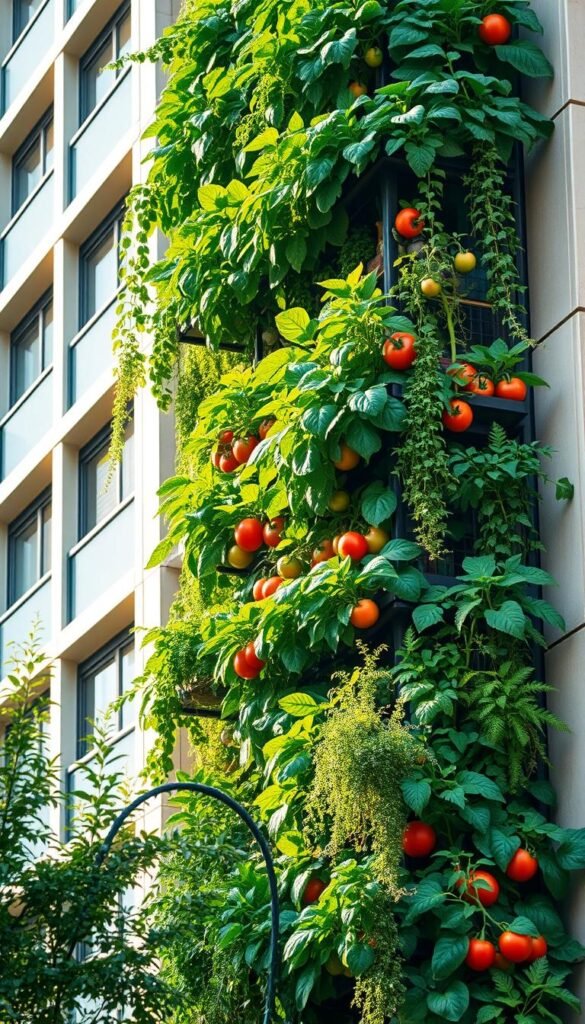
Reach new heights in your harvest by thinking upward, not outward. Vertical growing turns unused airspace into productive zones, letting you double usable area without expanding your footprint. This approach works magic in tight quarters while adding visual drama to your plot.
Using Trellises and A-Frames to Save Space
Sturdy supports transform vining crops into space-saving superstars. Bamboo A-frames wrapped with wire mesh handle heavy squash and melons. For lighter plants like peas, simple nylon netting between posts does the trick. Always anchor structures deeply – mature plants can weigh over 20 pounds!
| Crop | Best Support | Height Needed |
|---|---|---|
| Pole Beans | Trellis | 6-8 feet |
| Cucumbers | A-Frame | 4-5 feet |
| Malabar Spinach | Obelisk | 5-6 feet |
Ideal Crops for Vertical Growth
Some plants climb naturally, while others need gentle guidance. Use soft ties to train tomato stems weekly. Try these high performers:
- Self-clingers: Peas, nasturtiums, and passionfruit
- Needs training: Winter squash, indeterminate tomatoes
- Quick growers: Runner beans, Armenian cucumbers
Layer shade-tolerant greens like spinach under taller structures. The dappled light extends their growing season by 3-4 weeks in summer. Hanging baskets near supports add herbs or strawberries to the mix – a tasty use of overlooked spaces.
Designing Efficient Pathways and Accessible Garden Beds
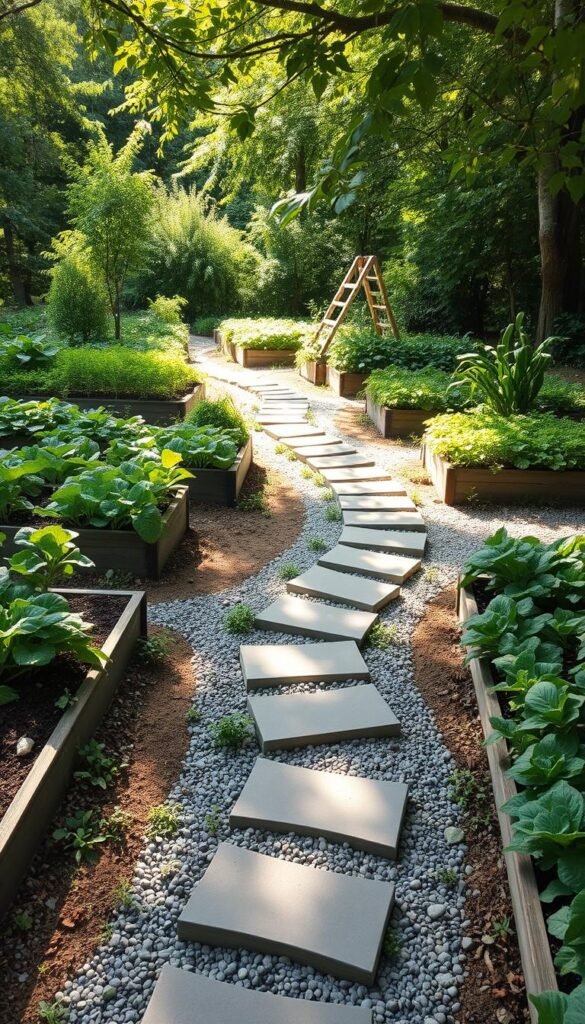
Smart pathway design turns cramped spaces into functional growing zones. The secret lies in creating access points that disappear when not needed. Keyhole layouts work wonders here – imagine circular beds with a single entry path that lets you reach every plant without crossing soil.
Start by measuring your tools. Wheelbarrows need 24″ wide paths, while handcarts manage with 18″. For foot traffic alone, 12″ suffices if you sidestep carefully. Use temporary boardwalks during wet seasons – they protect soil structure and can be stored when plants spread.
Material Choices That Serve Dual Purposes
Path surfaces impact both function and drainage. Compare popular options:
| Material | Durability | Drainage |
|---|---|---|
| Wood Chips | 2 seasons | Excellent |
| Gravel | 5+ years | Good |
| Pavers | Decades | Poor |
Rotate pathway locations annually where possible. Summer squash beds become winter garlic plots – shift walkways accordingly. Permanent paths belong near water sources and compost areas where you’ll always need access.
Crisscross patterns waste space. Instead, design main arteries with occasional dead-end spurs. This “fishbone” layout gives full bed access while keeping 80% of your area plantable. Remember: every square foot of path costs you 3-5 pounds of potential harvest!
Planning for Dense Planting and Strategic Thinning
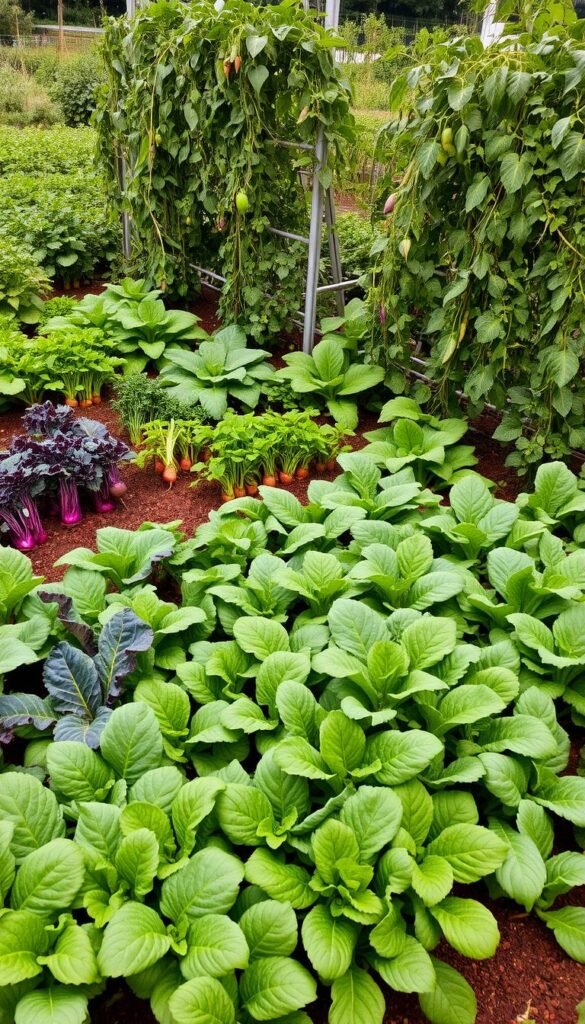
Unlock hidden potential in your plot by mastering two crucial skills: packing plants tightly and knowing when to remove extras. This dynamic approach lets you harvest more food while using every inch effectively.
How to Plant Densely for Maximum Output
Seed packets often suggest wasteful spacing for home growers. Try this instead: sprinkle seeds like confetti over prepared soil. For lettuce and spinach, scatter 20% more than recommended. As they grow, you’ll eat thinned plants as microgreens.
Best candidates for dense planting:
| Vegetable | Seed Density | Thinning Stage |
|---|---|---|
| Arugula | 1″ apart | 2-3 leaves |
| Radishes | 2″ clusters | 1 week old |
| Beets | 3″ groups | 4″ tall |
Effective Thinning Methods to Ensure Growth
Snip don’t pull – use scissors to remove crowded seedlings. This prevents root disturbance. For carrots, thin in stages: harvest pencil-sized roots first, leaving others to mature. Always water before thinning to soften soil.
Pair this technique with a square-foot garden plan for maximum efficiency. You’ll save 15 minutes per bed compared to row planting while growing 30% more food. Remember: extra seeds cost less than wasted space!
Implementing Companion Planting and Succession Strategies
Turn your plot into a teamwork paradise where plants help each other thrive. Smart pairings let you grow more food in the same space while keeping soil healthy. Unlike old wives’ tales, modern companion planting uses science to match crops with complementary growth habits.
Power Pairings That Pull Double Duty
The radish-carrot duo shows how timing creates efficiency. Scatter both seeds together – radishes sprout fast, marking rows while loosening soil. By harvest time, carrot seedlings get room to stretch. Try bush beans before beets too. Beans add nitrogen, giving beets a nutrient boost as they take over the space.
Keep the Harvest Train Rolling
Replace spring greens with summer stars like zucchini as temperatures rise. After garlic finishes, plant quick-growing rapini in its place. This succession strategy ensures no bare spots. Always have seedlings ready to fill gaps – a windowsill nursery keeps replacements handy.
These methods turn your garden into a 24/7 production zone. You’ll enjoy fresh picks from spring frosts to fall harvests while building richer soil each season. Now grab those seeds – it’s time to make every square foot work overtime!
